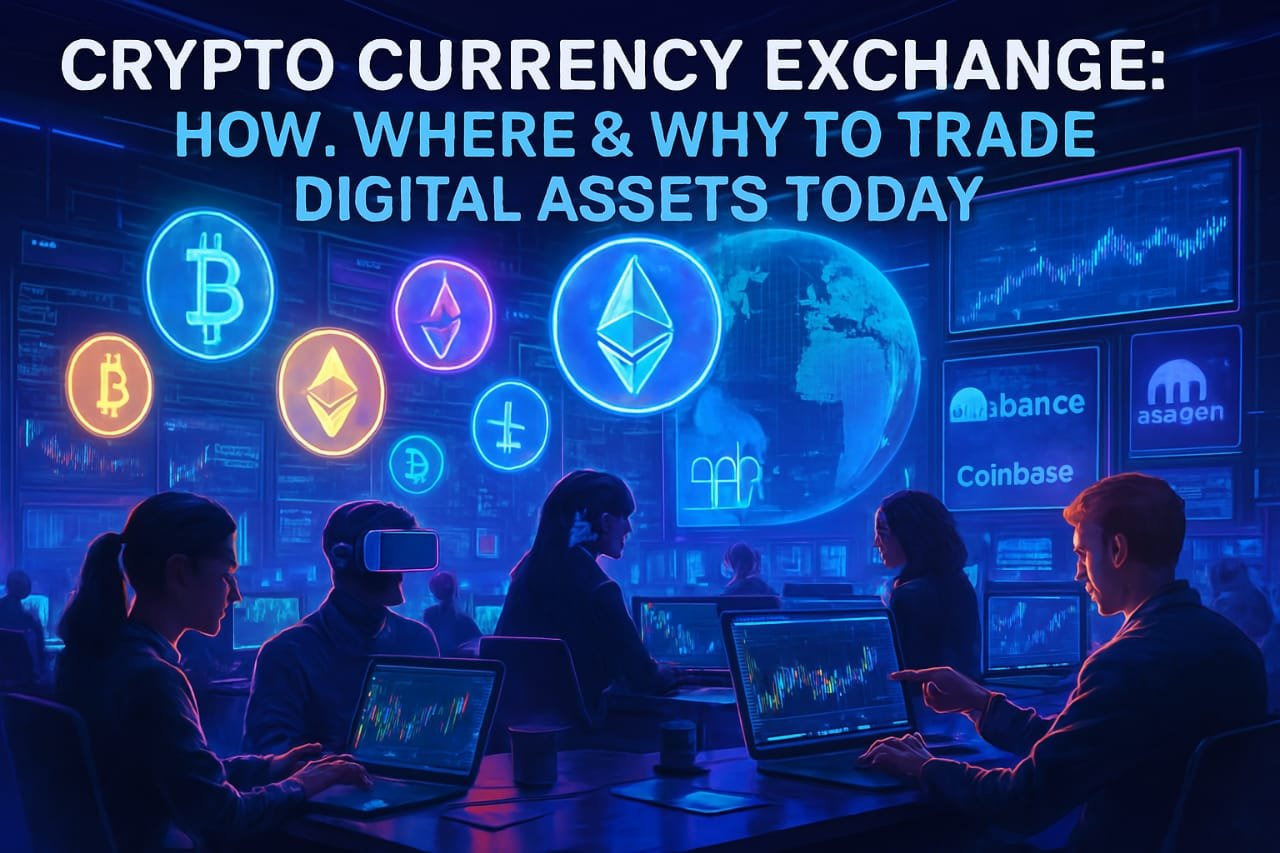Crypto Currency Exchange: How, Where & Why to Trade Digital Assets Today
In 2011, I first heard about Bitcoin—some “magic internet money” that people mined using computers. I shrugged it off. A decade later, that same Bitcoin hit over $60,000, and suddenly, everyone wanted in. But entering the crypto world isn’t as easy as buying snacks online. You need a trusted Crypto Currency Exchange—and that’s where things get interesting.

Whether you’re a beginner trying to buy your first token or a seasoned trader shifting from traditional assets, this guide will help you navigate the crypto exchange ecosystem with clarity, confidence, and smart strategy.
What Is a Crypto Currency Exchange and Why It Matters?
A Crypto Currency Exchange is a digital platform where users can buy, sell, or trade cryptocurrencies like Bitcoin (BTC), Ethereum (ETH), or newer altcoins like Solana (SOL) and Cardano (ADA).
Much like stock markets facilitate equity trading, these exchanges are marketplaces—only they operate 24/7, globally, and often with fewer intermediaries. There are two main types:
-
Centralized Exchanges (CEXs): Platforms like Binance, Coinbase, and Kraken act as middlemen, providing liquidity, wallets, and user-friendly interfaces.
-
Decentralized Exchanges (DEXs): These, like Uniswap or SushiSwap, let users trade directly from their wallets using smart contracts, skipping the middleman entirely.
Crypto Currency Exchange Comparison: CEX vs DEX Explained
| Feature | Centralized Exchange (CEX) | Decentralized Exchange (DEX) |
|---|---|---|
| Ease of Use | Beginner-friendly | Intermediate to Advanced |
| Security | Custodial (risk of hacks) | Non-custodial (user holds keys) |
| Speed & Liquidity | High liquidity, fast trades | Variable liquidity, slower |
| KYC/AML Requirements | Yes, often mandatory | Usually not required |
| Fees | Transaction + withdrawal | Network + liquidity fees |
👉 For beginners, CEXs are a good starting point. But as you grow in confidence and value decentralization, DEXs become an attractive alternative.
🧩 How to Choose the Best Crypto Currency Exchange for Your Needs
Not all exchanges are created equal. Here’s a checklist based on real-world trading experience and research:
✅ 1. Crypto Currency Exchange Security: What to Look For
Always choose exchanges with a strong history of protecting user funds. Look for:
-
Cold wallet storage (offline)
-
Two-factor authentication (2FA)
-
Insurance for digital assets
In 2019, Binance was hacked for over $40 million but reimbursed users fully thanks to their SAFU (Secure Asset Fund for Users). That’s the kind of protection you want.
✅ 2. Crypto Currency Exchange Fees: Hidden Costs You Should Know
A cluttered dashboard or slow app can ruin your trading experience. Platforms like Coinbase are renowned for their simplicity, while KuCoin or Kraken cater more to advanced users.
✅ 3. Which Crypto Currency Exchange Supports Your Country or Region?
Ensure the exchange lists the coins you want. Some only offer BTC and ETH, while others provide access to hundreds of altcoins.
✅ 4. Transaction & Withdrawal Fees
Low trading fees (0.1% or less) are ideal. Also, watch out for hidden fees during withdrawals or deposits—especially if you’re transferring large amounts.
✅ 5. Liquidity
Higher liquidity means better prices and faster trade execution. Top exchanges with global user bases generally offer better liquidity.
✅ 6. Regulation & Compliance
Choose regulated platforms if you prioritize legal protection. Exchanges like CoinDCX or WazirX cater to Indian users and follow local compliance frameworks.
The Rise of Decentralized Crypto Currency Exchanges
I remember trying Uniswap for the first time in 2020. The experience was clunky compared to Coinbase, but the freedom was palpable. No KYC, full wallet control, and access to thousands of tokens.

Why are DEXs gaining popularity?
-
Privacy-first: No identity verification needed
-
Token availability: Access to new and niche projects early
-
Control: You hold your private keys—not the exchange
Still, DEXs come with challenges: high gas fees, slippage, and the occasional rug pull. So, research is key before diving into new tokens.
Common Pitfalls to Avoid on Exchanges
Trading on a crypto currency exchange is exciting, but caution is essential. Here are some lessons I learned (often the hard way):
❌ 1. Keeping All Funds on the Exchange
Your exchange wallet is convenient—but also vulnerable. Always transfer long-term holdings to a hardware wallet like Ledger or Trezor.
❌ 2. Chasing Hype Without Research
In 2021, I FOMO’d into a trending meme coin. It spiked 3x in 2 hours… then crashed by 90%. Lesson? Always DYOR (Do Your Own Research).
❌ 3. Ignoring Platform Outages
During high volatility, even the best exchanges freeze or crash. Always have a backup plan (another exchange or a DEX) in case you need to exit quickly.
❌ 4. Using Leverage Without Understanding It
Some exchanges offer up to 100x leverage. But unless you’re a pro trader, this is gambling, not investing. I’ve seen friends lose their portfolios in minutes.
Key Trends in Crypto Currency Exchange (2025 and Beyond)
The exchange landscape is evolving rapidly. Here’s what’s shaping the future:
🔍 1. Regulatory Clarity
Governments are beginning to regulate exchanges, especially CEXs. While this adds transparency, it may reduce privacy and access for some users. Platforms like Gemini are setting high compliance standards globally.
🤖 2. AI-Driven Trading Tools
From bots to auto-portfolios, platforms now integrate AI to optimize user experience and trading outcomes. Bitget, for example, uses AI to help traders mirror strategies of top performers.
📱 3. Mobile-First Trading
Most exchanges now offer powerful mobile apps, making it easier to trade on the go. Look for security features like biometric login and push alerts.
🌐 4. Hybrid Exchanges
Projects like dYdX blend CEX-level UX with DEX-style decentralization. These may dominate the next wave of exchange adoption.
How to Get Started (Step-by-Step)
Beginner’s guide to using a CEX like Binance:
-
Sign up and complete KYC.
-
Secure your account (2FA, withdrawal whitelist).
-
Deposit funds via UPI, bank transfer, or crypto wallet.
-
Buy crypto using spot trading or convert feature.
-
Transfer to wallet for long-term holding or stake on the platform.
For DEXs like Uniswap:
-
Install a crypto wallet like MetaMask.
-
Fund it with ETH or another token.
-
Connect wallet to Uniswap.
-
Swap tokens directly.
-
Confirm via your wallet and pay gas fees.
Final Thoughts: The Exchange Is Your Gateway—Choose Wisely
A crypto currency exchange is more than a trading platform—it’s your entry point to the digital asset universe. Whether you’re building a diversified portfolio, looking to stake, or riding the latest DeFi wave, the exchange you choose shapes your journey.
Before you hit “Buy,” ask yourself:
-
Do I trust this platform?
-
Do I understand the risks?
-
Is this aligned with my financial goals?

If the answer is “Yes,” welcome aboard.
💬 What’s Next?
Still exploring crypto?
👉 Check out our guide on “Crypto Currency Basics”
Already trading?
👉 Explore strategies to grow your portfolio
Drop a comment below if you have a favorite exchange—or a cautionary tale. Let’s learn together. 🚀
